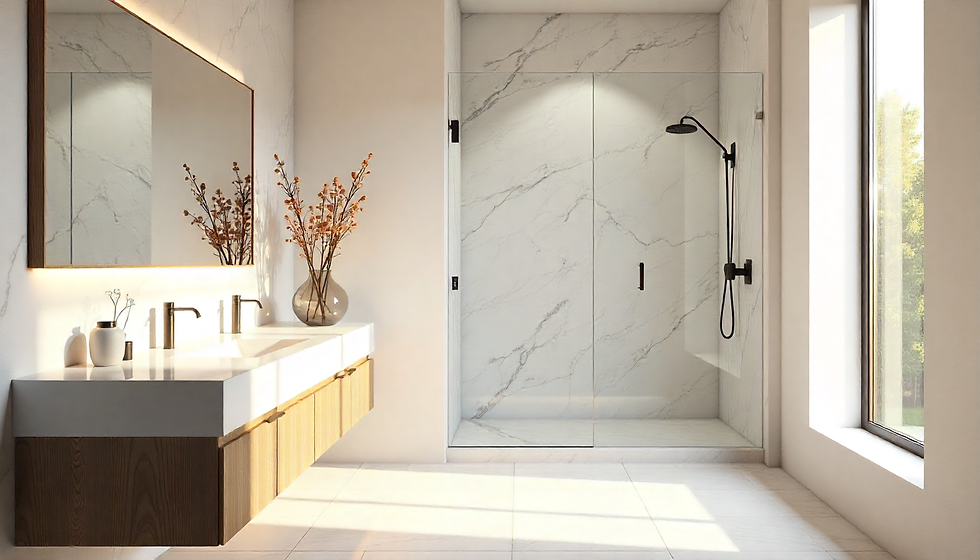How to choose a bathroom wall color?
- poseidon remodeling
- Oct 16
- 4 min read
How to choose a bathroom wall color? Choosing the right hue transforms a bathroom from functional to beautiful, and the decision is more than just picking a favorite swatch. Light, tile undertones, fixture finishes, and the room’s size all change how a color reads.
If you’re planning an oceanside bathroom remodeling project, coastal conditions and natural light change color performance and material longevity we’ll cover weather-related picks and mildew-resistant finishes.We also discuss trending palettes and durable, mildew-resistant paint options for lasting results.
Color basics and design principles
Deciding How to choose a bathroom wall color? begins with understanding bathroom paint color psychology. Colors alter mood: soft blues and greens soothe and expand small baths, warm greiges and creams feel cozy in master baths, and deep accents create drama when used sparingly.
Choosing neutral bathroom tones from bathroom trends because this is common strategy for long-term appeal. Neutral doesn’t mean boring muted slate, sage-gray, or warm greige provide a backdrop that’s easy to update with towels and hardware.
When pursuing oceanside bathroom remodeling, choose paints and finishes rated for coastal conditions to resist salt air and mold. Poseidon Remodeling recommends semi-gloss or satin finishes for easier cleaning, and professional surface prep to maximize adhesion and life span. Always sample large swatches, inspect at different times, and involve your contractor early so paint arrives in time for seamless installation.
bathroom-trends-2025
Looking at bathroom-trends-2025, designers are pairing wellness-driven material choices with color-forward neutrals for longevity and calm. Coastal projects emphasize colors that complement ocean views while resisting wear from salt and humidity. Durable materials and matte or low-sheen tiles that feel spa-like are rising in popularity, and colors that layer subtle green, greige, and soft blue remain top choices for both style and resale.
Spa-inspired natural palettes with tactile stone and matte tile.
Color-forward neutral schemes layering sage, greige, and pale blue.
Mildew-resistant paints and trims designed for humid environments.
These trends inform Kitchen remodeling and Bathroom remodeling and Home improvement work; Poseidon Remodeling helps clients choose palettes that balance trend and durability based on your home’s exposure and use.
Testing and finalizing choices
Always paint three swatch sizes: a small chip, a 6×6 painted swatch, and a larger painted panel on the actual wall. Observe each sample at morning, midday, and evening lighting. Choose paint sheens (satin/semi-gloss) that balance moisture resistance and finish appearance.
Budgeting, size-based pricing, and features that influence cost
When budgeting a bathroom color update within a larger remodel, understand the remodeling cost distribution breakdown: labor tends to be 35–40% of a full bathroom remodel, materials 40–45%, design and permits 10–15%, with a contingency of 20–30% (use the full 30 percent rule remodeling explanation for older homes or projects with plumbing and structural work). For projects that are primarily cosmetic, you can expect a lower contingency (10–20%), but always plan for surprises.
Size-based remodel pricing (typical updated ranges):
Small repaint/refresh (paint, trim, minor fixtures): $8,000–$15,000.
Medium remodel (new vanity, tile accents, modest layout change): $15,000–$35,000.
Large remodel or master suite (layout rework, new plumbing, premium finishes): $35,000–$80,000+.
Labor and material breakdowns: prep and demo work add time and cost; plumbing moves and tile rework drive the biggest increases. Premium tiles, custom vanities, and luxury fixtures increase material share of the budget. For oceanside bathroom remodeling, specify marine-grade or stainless hardware and mildew-resistant paints; these choices increase durability but can raise upfront costs.
Smart renovation spending strategies include prioritizing long-lasting, high-contact items (flooring, shower surrounds, ventilation) and economizing on decorative elements. Align painting with your schedule so primers and final coats apply in recommended humidity windows; in coastal climates this timing is especially important.
Conclusion
Choosing paint is both creative and practical. Test large swatches, consider coastal or indoor humidity factors, coordinate with tiles and fixtures, and budget for proper prep and ventilation so your chosen shade performs for years. Poseidon Remodeling helps homeowners make choices that balance color psychology and durability.
Contact us for a no-obligation consultation, sample boards, and clear cost estimates tailored to your bathroom and location. Contact us to discuss timelines, labor and material breakdowns, and how we apply the 30% contingency to protect your investment in Kitchen remodeling and Bathroom remodeling and Home improvement projects.
FAQs
Q: How many swatches should I test?
A: Test at least three sizes a chip, a 6×6 paint swatch, and a larger painted panel on the wall and view at different times of day.
Q: What sheen is best for bathrooms?
A: Satin or semi-gloss resists moisture and cleans easily; flat finishes can hide imperfections but are harder to keep clean.
Q: Should I follow trendy bathroom color palettes 2025?
A: Use trends as inspiration but balance them with durable materials and a palette that fits your home’s long-term style.
Q: How much contingency should I include for a bathroom remodel?
A: For full remodels or older homes, use the 30% rule; for simple repainting, a 10–20% buffer may be sufficient.
Q: Can Poseidon Remodeling handle coastal bathroom projects?
A: Yes—our team specializes in coastal finishes and material choices suited for seaside exposure and long-term performance.



Comments